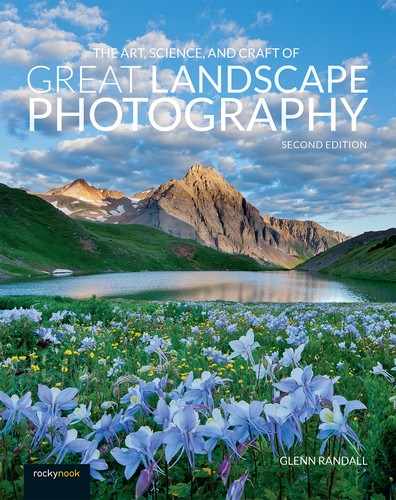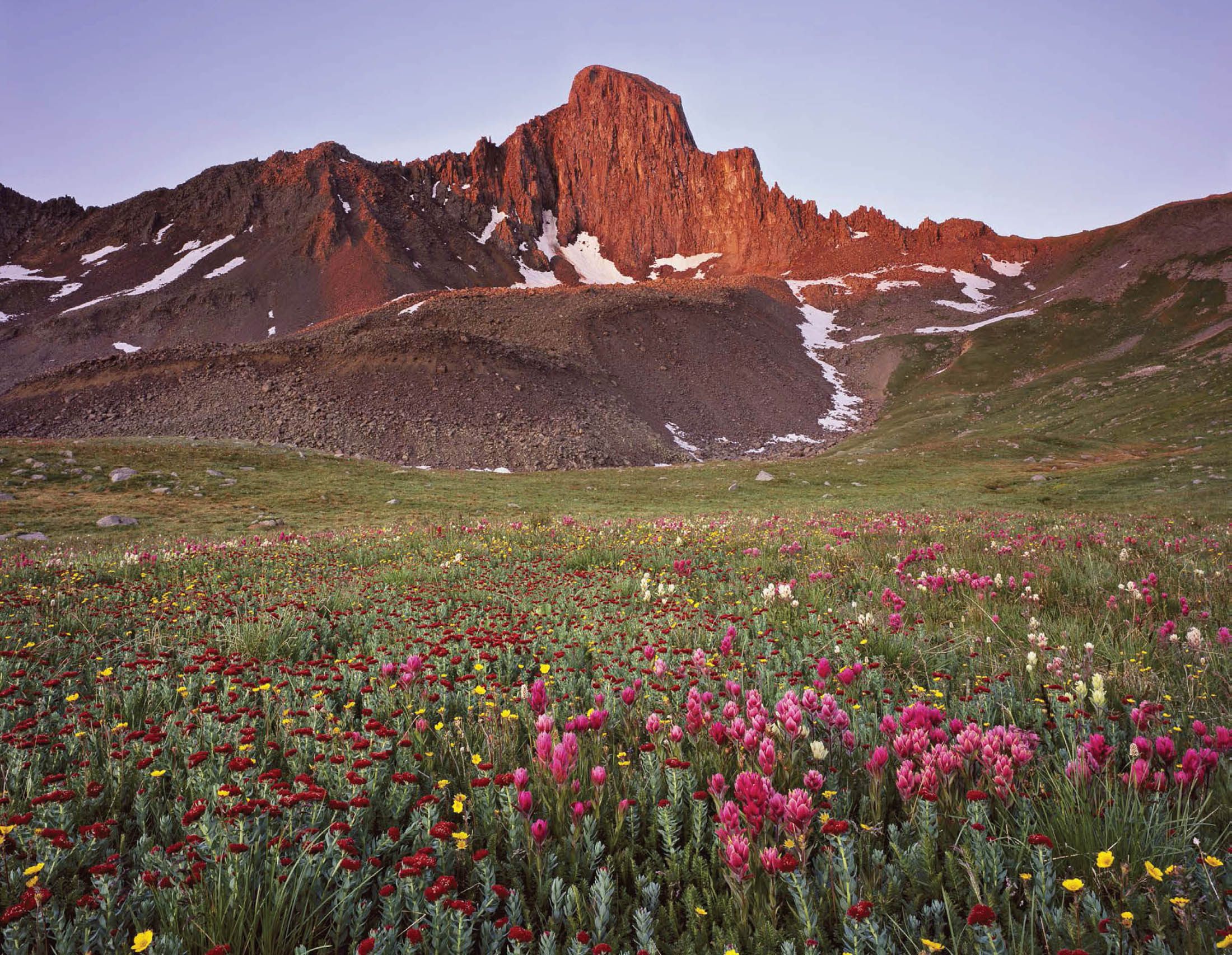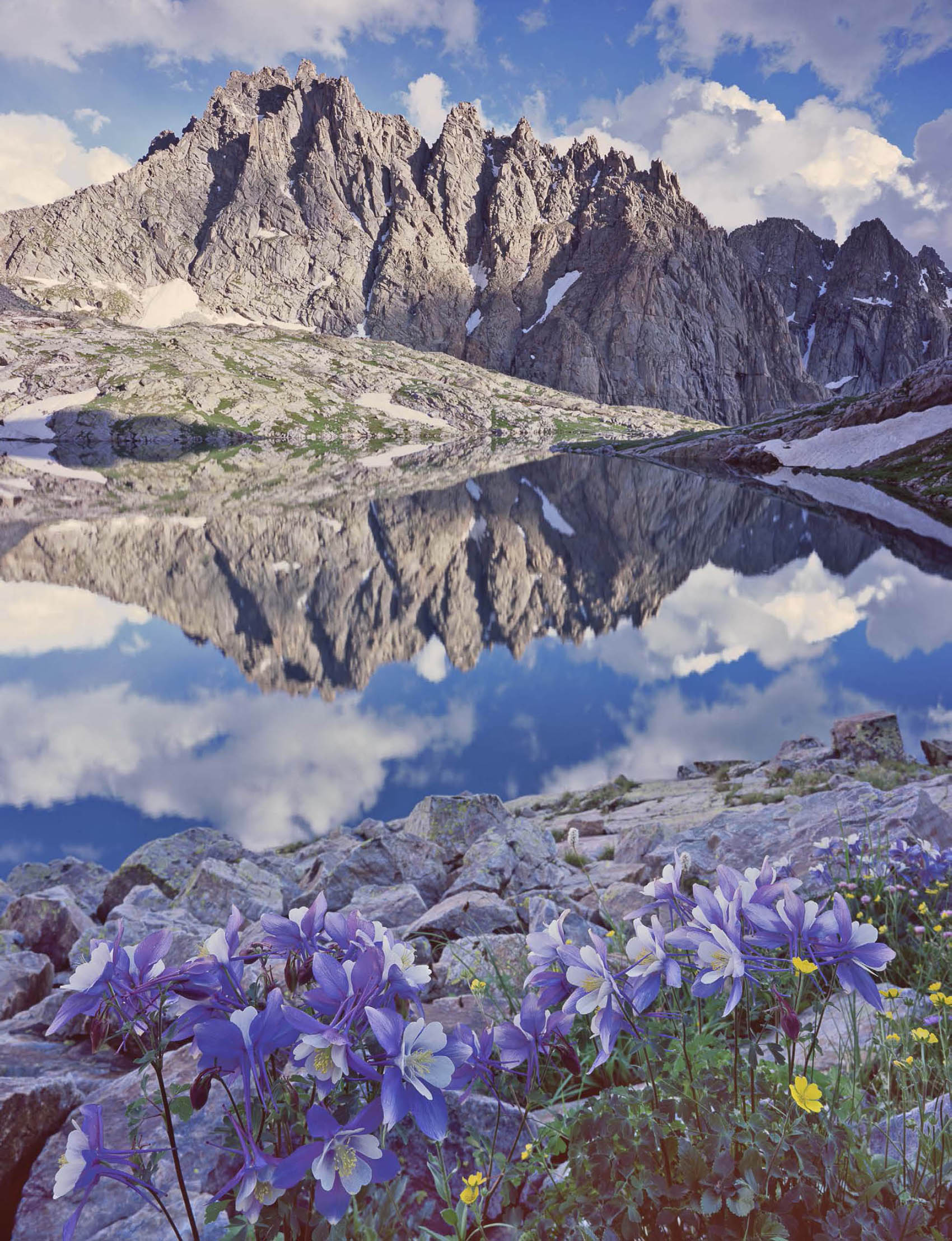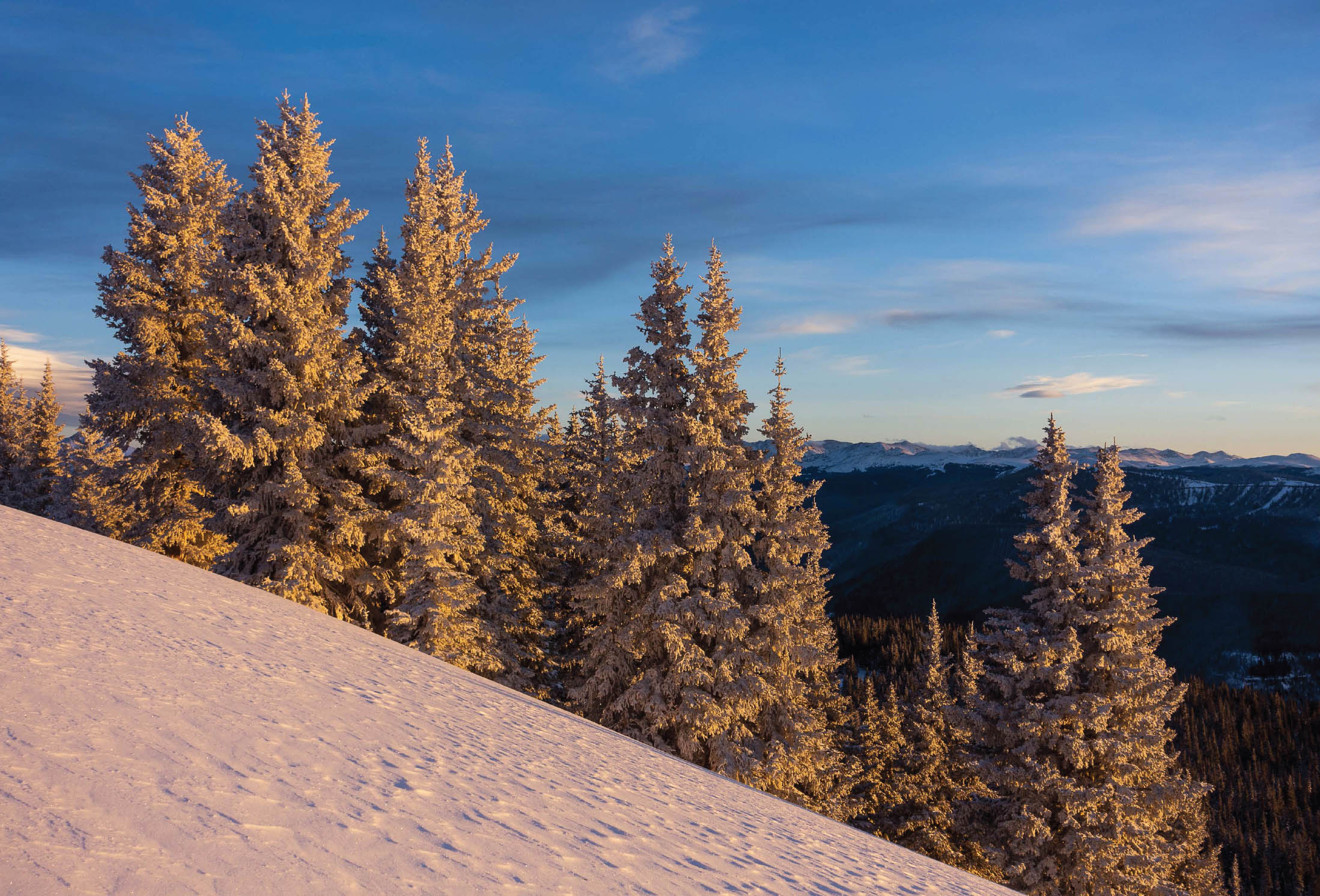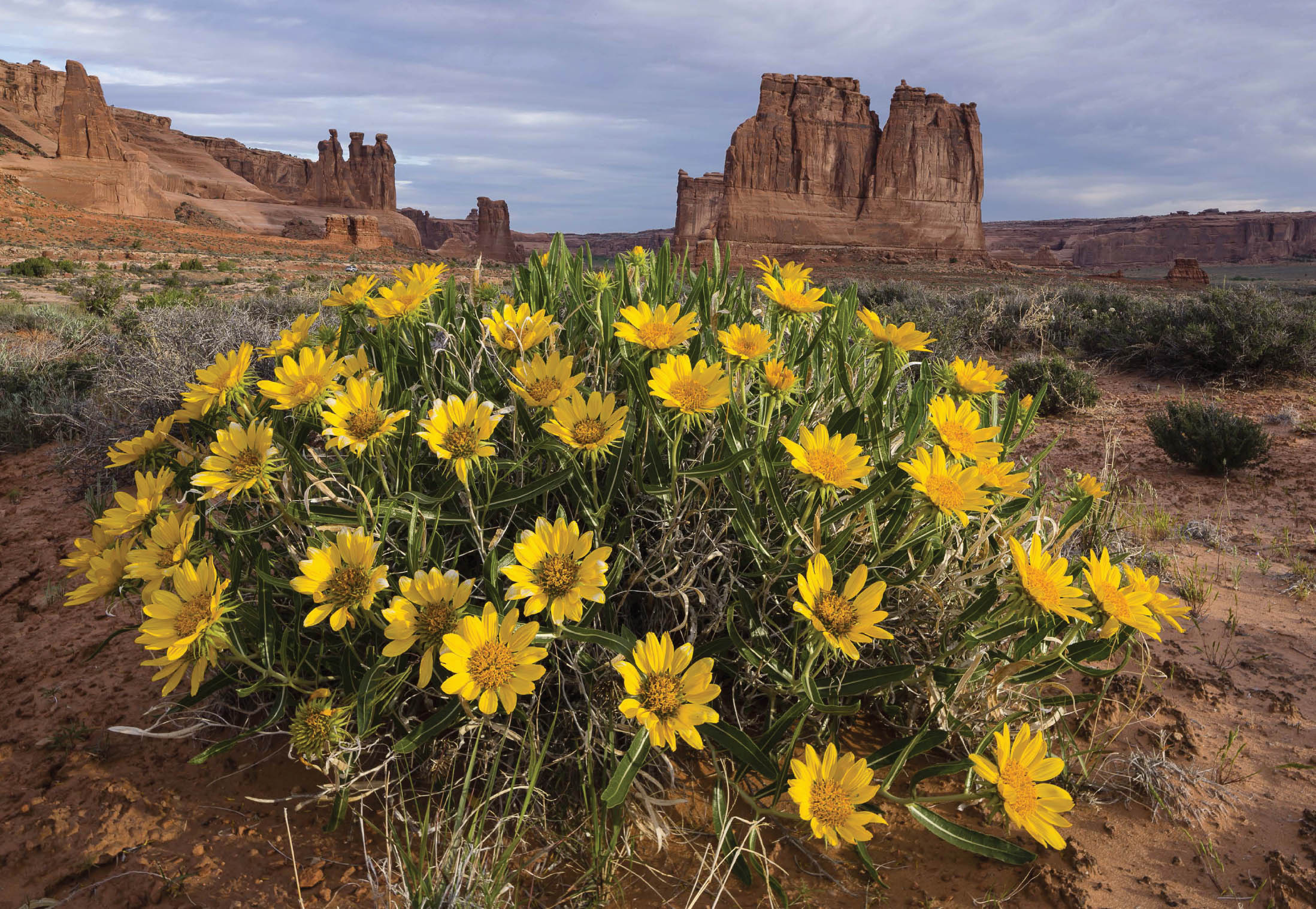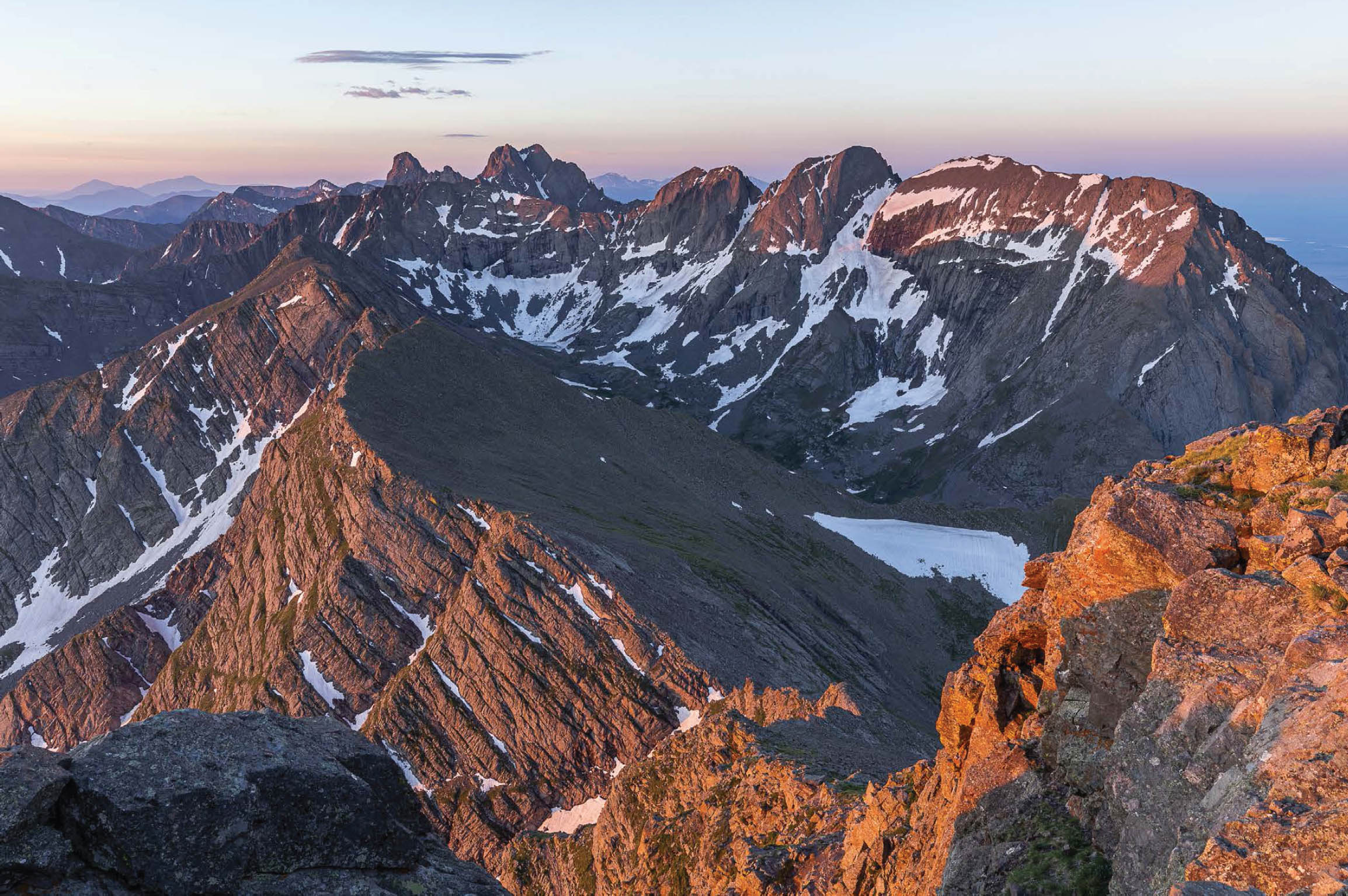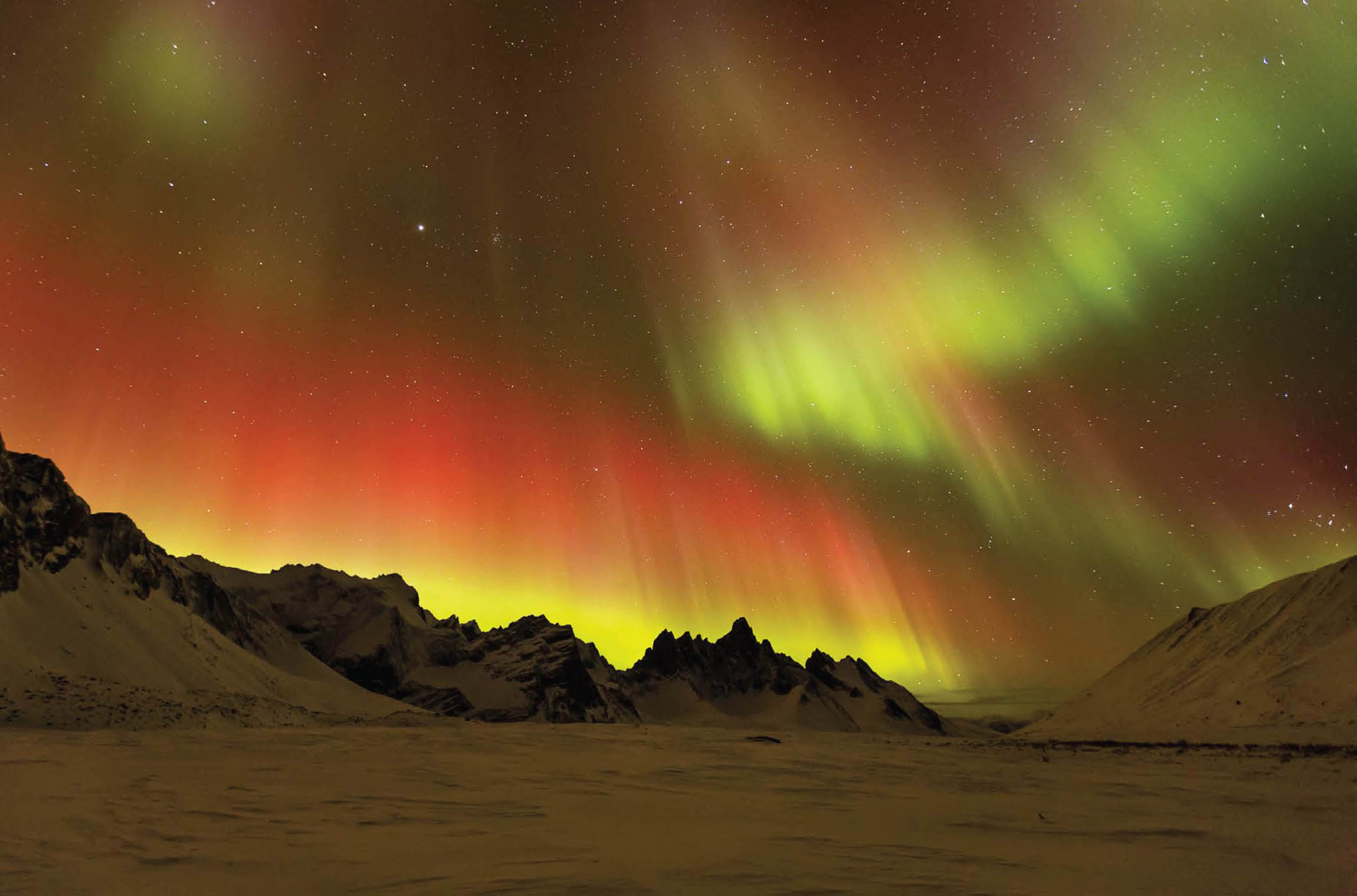11
The Psychology of the Compelling Landscape
For some photographers, making images that satisfy only themselves is enough. Others define success to mean accolades from friends and family. For professional landscape photographers, of course, the most critical measure of success is sales. It’s not enough to make images that capture their visual peak experiences in a way that satisfies only them. Pros must make images that speak to a wider audience. That’s easier said than done. Even highly experienced photographers can find it difficult to predict which of their images will truly resonate with viewers. Understanding the psychology of the viewer can help both pros and amateurs make more compelling images.
I began producing prints of my Colorado landscapes in 1994. Soon I was making much of my income selling matted-and-framed prints in various galleries and gift shops. Each autumn, in preparation for the Christmas rush, I would look back through the previous year’s work and try to decide which new images to introduce. Even after several years of experience, however, my ability to predict which images would sell was poor. In a typical year, half of my new images failed to sell, and half succeeded.
Why was my own judgment so unreliable? Despite my best efforts, I couldn’t really see my images through the eyes of others. I knew how many hours I’d driven and miles I’d hiked to reach that location, how many times I’d risen long before sunrise or stayed up way past my bedtime in order to be at the right place at the right time, how much wind and cold I’d endured, how many hours I’d waited for the perfect light. The viewers of my images knew none of that. All they could see was the image itself.
One year I decided to see if I could improve my dismal results by conducting focus groups with neighbors and my wife’s colleagues. These people weren’t familiar with my work, so I presented the group with a mixture of best sellers and new images and asked them to rank the images by their appeal as wall art. I figured that if a new image got the same ranking as an established, popular image, I could confidently offer the new image for sale and watch the money roll in.
It didn’t work out that way. In many cases, best sellers received low rankings. How could that be? I was baffled. Clearly, however, I could not rely on the results of the focus group to predict which images would succeed.
One of the insights of modern psychology is how much our preferences and decisions are driven by unconscious processes. Often our conscious mind merely provides rationalizations for decisions our unconscious mind has already reached. In his book The Happiness Hypothesis, psychologist Jonathan Haidt wrote, “When you see a painting, you usually know instantly and automatically whether you like it. If someone asks you to explain your judgment, you confabulate. You don’t really know why you think something is beautiful . . . . You search for a plausible reason for liking the painting, and you latch on to the first reason that makes sense (maybe something vague about color, or light, or the reflection of the painter in the clown’s shiny nose).”
FIGURE 11-2 Indian paintbrush, king’s crown, and Wetterhorn Peak at sunrise, Uncompahgre Wilderness, Colorado. This image of one of Colorado’s most rugged 14,000-foot peaks, bathed in sunrise light with a carpet of wildflowers at its feet, is one of my personal favorites. It had sold fewer than 10 prints when I discontinued it. Ebony SW-45 field camera, Fujichrome film. Lens and exposure unrecorded.
Solid evidence of the power of the unconscious comes from a study conducted by advertising researcher Bruce Hall that used my images. Hall gathered a group of my Colorado landscape images that had been offered for sale as prints. Some had succeeded; others had flopped. Hall showed them to his colleagues and asked them to rank the images in order of preference. During the viewing session Hall recorded their heart rates and skin conductance, both of which correlate with emotional arousal and involvement.
FIGURE 11-3 Jagged Mountain reflected in an unnamed Lake, Weminuche Wilderness, Colorado. I shot this photo in the most remote and rugged part of the Weminuche Wilderness. It was the first and only time I have ever found a group of columbines growing where I could include the flowers, a rugged peak, and the complete reflection of the peak. I thought for sure it would become a best seller. Instead, I sold only seven prints before I discontinued it. It still speaks to me, but clearly not to a broader audience. Ebony SW-45 field camera, Fujichrome film. Lens and exposure unrecorded.
Some colleagues had near-zero interest in the category of Colorado landscape photos. Others had a moderate interest. Regardless of their level of interest, the test subjects were about equally likely to predict (or fail to predict) which images would sell. In fact, only one-third of the variation in sales could be explained by the stated preferences of the test group.
Then Hall examined the data on heart rate and skin conductance. For those subjects with no interest in landscape photography as a category, there was almost no correlation between the physiological measures and sales. For those subjects who were interested, however, there was a significant correlation between these physiological measures, which represent unconscious emotional reactions, and how well a particular print had sold. In his book Why Advertising (Sometimes) Works, Hall wrote, “Why is this significant? It demonstrates the critical importance of relevance in triggering emotional responses from respondents. If the stimulus is not relevant to them, consumers will not focus their attention on it. And if they are not attentive, they will experience no meaningful perception.” More broadly, Hall concludes that roughly two-thirds of the decision-making process in sales of prints is driven by unconscious processes. He then quotes legendary adman David Ogilvy, who once said, “Consumers do not behave as they say, they do not say what they think, and they do not think what they feel.”
Landscape Photography and Evolution
If the unconscious is a primary driver of preferences in landscape photography, where do those unconscious preferences come from? One plausible possibility is evolution.
We have a lot in common with other mammals. We need food and water. We need shelter from storms, severe cold, and heat. We need to be able to spot predators and enemies from afar, without being seen ourselves, and we need refuge from those threats if they continue to approach. To find food, water, and shelter, we need to explore our environment. Meeting these needs was crucial as we evolved on the plains of East Africa.
Nearly all animals have a preferred habitat. Many, in fact, are adapted to only one type of habitat and will die if that habitat disappears. Could it be that humans also have a preferred habitat? And, if so, do we prefer landscape photographs that show that preferred habitat?
At first blush, that seems absurd. Humans now live in almost every possible environment, from tropical South America to the South Pole. How can I argue that we have a preferred habitat?
Some researchers in the field argue that we still have a preferred habitat and that it hasn’t been long enough, in an evolutionary sense, for those preferences to disappear. It’s only been 125 generations since the Bronze Age and 250 generations since the Stone Age. The first creatures we can identify as hominids were apelike creatures who descended from the trees and began living on the ground during the Pleistocene. We evolved for 80,000 generations on the plains of East Africa. The fact that we no longer need to hunt down dinner every day while simultaneously avoiding predators and enemies doesn’t mean that all those instincts, tastes, and needs have disappeared. In his book The Art Instinct, New Zealand philosopher Denis Dutton cites J. B. S. Haldane’s 1927 calculation that “a (genetic) variant that produces on average 1% more offspring than its alternative allele (genetic variant) would increase in frequency from 0.1% to 99.9% of the population in just 4,000 generations.” In other words, even a small preference for landscapes that more readily satisfied human needs could easily have become embedded in the genes of virtually the entire population. Those preferences still linger, even if not everyone can act on them and live where they would truly prefer.
FIGURE 11-4 Vestal Peak and Arrow Peak reflected in a pond at sunrise, Weminuche Wilderness, Colorado. Is the appeal of this image due in part to the presence of water, green grass for wildlife to graze, and terrain that invites exploration? Canon EOS 5D Mark III, Canon EF 16-35mm f/2.8L II USM at 26mm, 1/50th, f/16, ISO 100.
FIGURE 11-5 Frosted trees along the west ridge of Bald Mountain at sunset, Gore Range, near Vail, Colorado. As a category, winter images are much less popular than spring, summer, and fall images. The most popular ones often feature warm light, perhaps because it helps the viewer imagine the warmth of the sun on their face. Sony DSC RX100 III compact digital camera, non-interchangeable zoom lens set to 42mm full-frame equivalent focal length, 1/30th, f/8, ISO 80.
Dutton goes on to point out that European pigeons introduced into New Zealand still instinctively fear snakes even after 200 pigeon generations, although there are no snakes in New Zealand and never have been. Once while hiking to a photo location in southeast Colorado, I heard a rattlesnake sound its warning. I nearly jumped out of my skin, although I had never before heard a rattler in the real world and the snake turned out to be only about 18 inches long. My wife and daughter are phobic about spiders although neither has ever been bitten by one.
More than we care to admit, we are creatures of our evolutionary past. What does that mean in terms of our appreciation of landscape, and by implication, landscape photographs?
Jay Appleton, a geographer at the University of Hull in England, has written a book called The Experience of Landscape in which he laid out an evolutionary perspective on what types of landscapes we find pleasing. His ideas can be summarized in the form of three theories: habitat theory, prospect-refuge theory, and the savanna hypothesis (which was initially developed by Gordon H. Orians, professor emeritus of biology at the University of Washington).
Habitat theory postulates that we take pleasure in landscapes that look like they could satisfy our biological needs. Prospect-refuge theory asserts that we like landscapes that offer a prospect, to use Appleton’s term: a long view, often from an elevated vantage point. But we also need to escape predators, hide from enemies, and take shelter from severe weather, so we look with favor on landscapes that offer potential refuges. The savanna hypothesis asserts that we prefer landscapes that resemble the plains of East Africa where we evolved. At that point in our evolutionary history, the savanna was much wetter than East Africa is today.
Orians lists the following characteristics of an idealized human habitat, which bears a striking resemblance to the savannas where we evolved:
FIGURE 11-6 Summer sunrise at Bear Lake, Rocky Mountain National Park, Colorado. Does the elevated vantage point, which gives a commanding view of the lake below, along with the foreground trees, which appear to offer the viewer partial concealment from predators and prey, add to this image’s appeal? Ebony SW-45 field camera, Fujichrome film. Lens and exposure unrecorded.
- open spaces of low grasses interspersed with thickets of bushes and groupings of trees;
- the presence of water directly in view, or evidence of water nearby or in the distance;
- an unimpeded view of the horizon in at least one direction;
- evidence of animal and bird life; and
- a diversity of greenery, including flowering and fruiting plants.
Humans are less attracted to absolutely open, flat grasslands and more attracted to moderately hilly terrain. In other words, we like landscapes where we can see opportunities to hike to the top of a hill and check out our surroundings, or, better yet, landscape photographs taken from elevated vantage points that directly reveal the lay of the land. Including the horizon helps us orient ourselves in space, which adds still more appeal. We also like landscapes that invite exploration, where we feel we could walk right into the frame and stroll along the grassy bank of a stream or lake or follow a path around a bend. We prefer savannas that are green rather than ones that are brown and dry. Stephen and Rachel Kaplan, professors of psychology at the University of Michigan, have shown that the most desirable landscapes have a moderate degree of complexity. Extremely intricate landscapes, such as impenetrable forests and jungles, are just as unattractive as utterly simple landscapes, such as prairies.
Habitat theory helps explain why water is such an appealing element in many successful landscape photographs. We must drink water every day and cannot survive long without it. Watering holes attract game, making hunting easier. Lakes, rivers, and oceans contain fish, a valuable source of protein and calories. Our ancestors would have found well-watered country tremendously appealing. Even today, waterfront property, and property with a view of water in the distance, is more expensive worldwide. It’s no wonder that water in a landscape photograph enhances the image’s appeal.
Habitat theory also helps explain the perennial appeal of wildflowers. Lush blooms were another sign of habitats blessed with abundant rain. Flowers also made it easier to identify specific plants in the mass of similar green leaves and held the promise of edible fruits and seeds in the weeks to come.
If greenery is so popular, should we all stop shooting in the desert? One study of Phoenix residents’ preferences in terms of landscaping around their homes found that they all said they liked desert landscapes; however, if given a choice, money no object, most said they preferred a green lawn rather than xeriscaping. They liked the idea of creating a little oasis to live in. Many of the most popular desert shots show rare spring blooms, or a little bit of water—scenes that are certainly not typical of the desert’s appearance for most of the year. According to Dutton, research has shown that women prefer their landscapes lush and green, with plenty of flowering and fruiting plants as evidence of the land’s fertility, plus an ample supply of potential refuges. Men prefer landscapes that offer vast vistas, invite exploration, and look like rich hunting grounds.
FIGURE 11-7 Rough mule’s ears and the Organ, Arches National Park, Utah. Many of the most popular desert images show rare springtime blooms. Canon EOS 5D Mark III, Canon TS-E 24mm f/3.5L II tilt-shift lens, 1/15th, f/16, ISO 100.
The Kaplans have also pointed out that we like our landscapes to have an element of mystery, which they define as a feeling that “one could acquire new information if one were to travel deeper into the scene.” I think we like mystery for an additional reason: it allows us to imagine a story about the image. Suggesting a story is easiest to do with photographs of people, since we can imagine their trials and triumphs just by studying their faces and surroundings, but the same principle can work in landscapes that show peaks or canyons half-obscured by clouds or fog.
Prospect-refuge theory offers another intriguing way to think about why some images succeed and others fail. It may help explain the enduring appeal of frame-within-a-frame compositions, which place two foreground elements, such as trees or rock pillars, on either side of the frame, with a more distant view revealed in between. These framing elements partially conceal the viewer and help prevent discovery by potential enemies and predators, but still allow a view into the distance. Frame-within-a-frame compositions are even more attractive if they place the viewer at some height above the surroundings. As Dutton points out, “Human beings like a prospect from which they can survey a landscape, and at the same time they enjoy a sense of refuge. A cave on the side of a mountain, a child’s tree house, a house on a hill, the king’s castle, the penthouse apartment, and a room with a view are situations with appeal (in fact, with a few exceptions, higher-elevation real estate for housing is more expensive worldwide).” Dutton goes on: “In fact, most landscape representation in the history of painting places the implied viewer either at some desirable vantage point—a cliff edge, perhaps, typically looking down into a valley—or, if at ground level, at a somewhat greater height than what would be accurate for a six-foot human being.”
FIGURE 11-8 Sunrise from the summit of High Dune, Great Sand Dunes National Park, Colorado. The fog filling the valleys between the dunes lends an air of mystery to this image. Canon EOS 5D Mark III, Canon EF 16-35mm f/2.8L III USM at 32mm, three-frame bracket set, one-stop bracket interval at ISO 100, images merged using Lightroom Classic’s Photo Merge>HDR utility.
FIGURE 11-9 Crestone Needle, Crestone Peak, and Kit Carson Mountain from the summit of Mt. Adams at sunrise, Sangre de Cristo Wilderness, Colorado. This image combines an extreme prospect (the view from the summit of a 13,940-foot peak), with many hazard symbols (nearby and distant cliffs). Canon EOS 5D Mark IV, Canon EF 16-35mm f/2.8L III USM at 27mm, three-frame bracket set, two-stop bracket interval at ISO 100, images merged using Lightroom Classic’s Photo Merge>HDR utility.
Although an elevated vantage point is often desirable, photographers don’t need to climb to the top of a peak to use a mountain as a prospect symbol. Simply including a mountain in the frame lets us imagine ourselves on the summit enjoying a view that seems to go on forever. The sensation of a prospect can be created in other ways as well. Clear air coupled with a distant horizon also creates a long view—a long “fetch” to use Appleton’s term—and encourages speculation about what may lie beyond the horizon. Such long views tend to draw the eye, which can be important in terms of guiding the viewer’s gaze around the frame. Aerial photographs may give an extreme sensation of prospect, but at the cost of any sense of participation in the landscape below.
Refuge has no meaning without a hazard to take refuge from. People love the thrill of coming close to peril without really being in danger. Little kids like to be scared just a little bit. Many people love roller coasters for just this reason. We love to be perched on the edge of a thundering waterfall. Photographs that show violent weather approaching, but that include something in the scene that indicates you can still find shelter, have perennial appeal. Cliffs, steep peaks, large breaking waves, powerful rapids, and deep chasms are all reliable hazard symbols. Shadows, on the other hand, are ambiguous. They are hazard symbols if they appear to conceal a threat, but refuge symbols if they look like a place where the viewer can hide. Pair strong hazard symbols with powerful refuge symbols in a landscape image, and you may have a winner.
By now you may be thinking, “Don’t people have different tastes around the world? After all, Japanese gardens don’t look like British gardens.” While this is true, it does not, according to Appleton, disprove his hypotheses. He writes, “Taste is an acquired preference for particular methods of satisfying inborn desires.” Research has shown a surprising degree of uniformity in the types of images preferred around the world. In 1993, Vitaly Komar and Alexander Melamid, two Soviet artists who had taken up residence in the United States, received a grant to do a worldwide study of preferences in paintings. Dutton described the results: “People in very different cultures around the world gravitate toward the same general type of pictorial representation: a landscape with trees and open areas, water, human figures, and animals. More remarkable still was the fact that people across the globe preferred landscapes of a fairly uniform type: Kenyans appeared to like landscapes that more resembled upstate New York than what we might think of as the present-day flora and terrain of Kenya.”
Although some dismiss this as the influence of the worldwide calendar industry, Dutton sees the hand of evolution at work. He sums up habitat theory and its corollaries well: “In the Pleistocene, habitat choice was another factor determinative of life and death, and emotional indifference to landscapes is as evolutionarily unlikely as indifference toward snakes, dangerous precipices, and poisonous foods, on the one hand, or sex, babies, and sweet and fatty foods, on the other.”
On Culture and Creativity
I’m certainly not arguing that evolution explains all of our preferences in landscape photographs. Culture clearly plays a crucial role. In the Middle Ages, wilderness was something to be feared and shunned; in colonial America, it was something to be conquered, which usually meant chopping down all the trees and altering its character completely. The appreciation of wilderness as something beautiful and soul-restoring only took root in popular culture over the last hundred years or so. Today a photograph that portrays wilderness as gentle and welcoming is often appealing.
FIGURE 11-10 Ramparts Falls, Cameron River Crossing Territorial Park, along the Ingraham Trail near Yellowknife, Northwest Territories, Canada. Powerful waterfalls are reliable hazard symbols; the presence of solid rock at the bottom of the frame indicates the viewer is close to danger without really being in peril. Canon EOS 5D Mark III, Canon EF 16-35mm f/2.8L II USM at 23mm, 1/5th, f/16, ISO 100.
We appreciate good landscape photographs for other reasons as well. We find them appealing because of the formal beauty of their graphic design. We enjoy them if they capture some superlative: the reddest sunset, deepest snow, most expansive field of wildflowers, or richest fall color, although a great landscape photograph doesn’t have to embody some superlative to succeed. We also value a landscape image if it showcases a view we’ve never seen before. At this point in my life, I’ll never make it to the summit of Mt. Everest, so a photograph from the summit is fascinating to me even if it was taken with a cell phone. We treasure a landscape photograph if it is iconic, a single image that sums up a complex whole. And we love landscape photographs that are creative.
It’s important to distinguish between photographs that are merely different and those that are genuinely creative. Different is easy; creative is hard. An image that is merely different strikes the viewer as odd or puzzling. An image that is creative impresses the viewer as something much more. In his book How Advertising (Sometimes) Works, Bruce Hall gave a definition of creativity that rang true for me: “Creativity is the connection that occurs when seemingly unrelated ideas collide and bond in a new, logical, and suddenly obvious way. Often, a person with a rich mental data bank of experience and knowledge may act as the catalyst. When that person’s disparate brain regions are granted the time and opportunity to share some of that seemingly unrelated knowledge and data, the result may be a connection no one has ever made before, which provides a creative solution to a previously insoluble problem.”
FIGURE 11-11 Aurora over Tombstone Mountain, Tombstone Territorial Park, Yukon Territory, Canada. Photographs of extremely rare events like the otherworldly auroras sparked by the 2015 St. Patrick’s Day geomagnetic storm can be powerful even if the landscape depicted hardly looks hospitable to human life. Canon EOS 5D Mark III, Canon EF 16-35mm f/2.8L II USM at 16mm, 10 seconds, f/2.8, ISO 1600.
What struck me about this quote is the idea that creativity does not emerge fully formed from the void. Instead, it emerges when someone makes a new connection between the countless bits of information already stored in their head. In this book I have tried to impart a deep and broad knowledge of the many elements of landscape photography. I have tried to explain why something works or is true, rather than simply presenting techniques without explaining how they work. I believe it’s easier to remember a procedure or principle if you know why it works, and not merely that it does work. I also believe knowing why something works fosters creativity. If you understand the whys, you can more easily visualize connections between apparently unrelated facts and ideas. If you can visualize many possibilities, you stand a better chance of hitting on the one that will be genuinely creative. And when that happens, you will truly have mastered the art, science, and craft of great landscape photography.
FIGURE 11-12 Perseid meteors over Turret Arch, Arches National Park, Utah. The Perseid meteor shower occurs every year, but the peak only lasts one or two nights, and moonlight and clouds can ruin one of nature’s most spectacular fireworks displays. This image is a composite of 49 meteors shot on the nights of August 10-11, 11-12, and 12-13, 2018. I shot a total of 3,780 frames for the meteors. I shot the land as a single-row panorama with a Canon EF 35mm f/1.4L II USM, 40 seconds, f/1.4, ISO 6400. I shot the sky as a two-row panorama, three camera positions per row, Canon EF 35mm f/1.4L II USM, 10 seconds, f/1.4, ISO 6400. I used two cameras to shoot the meteors: a Canon EOS 5D Mark III with a Canon EF 24mm f/1.4L II USM lens, exposing at 20 seconds, f/1.4, ISO 3200, and a Canon EOS 5D Mark IV with a Canon EF 16-35mm f/2.8L III USM at 16mm, exposing at 30 seconds, f/2.8, ISO 6400.
